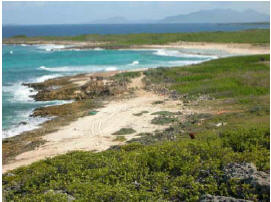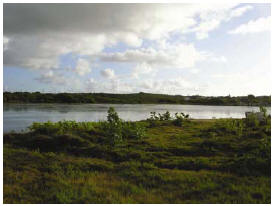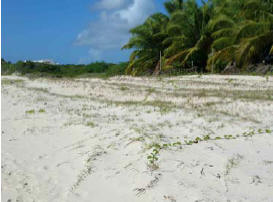|
|
|
|
|
|
|
| Eco-Corner: Do Good Things Come in Small Packages?: Protected Areas in Anguilla | ||||||
|
This year, there had been much discussion about protected areas in Anguilla: the Government of Anguilla (GOA) has just recently approved the creation of a national park at Cove Bay and it had raised the possibility of creating one at Long Bay. This push to preserve land for Anguillians comes at an important time: large scale development, particularly along the coastline, continues at an unprecedented pace. While the GOA has embraced economic growth through built development, it is becoming more difficult for it to ignore the social and environmental implications that come with it.
Despite a two-year moratorium on new large-scale, foreign-led development initiatives, a substantial number of project proposals that had been submitted to the GOA prior to the moratorium’s commencement in November 2005 had been considered and, in some cases, are underway. Significant local investments that still put pressure on the labour market and on the natural environment are not included under the moratorium. And now, with the moratorium soon coming to an end, the economic and environmental situation of this small island requires decision-makers and the public alike to ask questions regarding the sustainability of such a path of development and the trade-offs that come with it: Are we doing enough to ensure that the land can sustain this level of development and are we setting aside enough “green” space – protected areas - to compensate for land loss and the impacts of our actions? Protected Areas Management While protected areas management has both natural and social science components, it is firmly rooted in a foundation of ecosystems, habitats, species, ecological integrity, and conservation. Ecosystems are the communities of living organisms and their surroundings. Habitats are the places in which species live and grow. Species refers to types of organisms that are categorised together because of their common features (including their genes and DNA) and because they can interbreed. Ecological integrity, meanwhile, refers to an environment that is healthy because its natural components (for example, plants, animals, and other organisms) and processes (for example, growth and reproduction) are working properly. Finally, conservation refers to the protection, preservation, management, and/or restoration of species and the habitats on which they depend. Conservation allows for wise and appropriate use so long as ecological integrity is not compromised. Protected areas are based on all of these components of the environment and on the concept of conservation. Although the type of protected area that is ultimately established depends on its purpose and its objectives, conservation of the natural environment is usually one of the high-level priorities. The focus on conservation is important because it is what protects biodiversity - all of the living organisms that are found on the island (and the Earth) as well as the natural resource base that supports our livelihoods. Protected areas also help to maintain the ecosystem services (the conversion of carbon dioxide into oxygen, the cycling of nutrients, the creation of food and clean drinking water, the controlling of climate) which we rely on to survive. Anguilla, as a small island developing state, is particularly vulnerable to changes in ecosystem function because of its size, flatness, and relatively uniform vegetation. Furthermore, climate change and its associated sea level rise, increase in severe storm activities, longer dry seasons, and temperature increases pose additional stress on this tiny island. In this new reality, it has become even more important to take steps that will help Anguilla to respond and adapt to these changes. At the same time, the island’s environment and its processes and services are being impacted by more stresses than just climate change. They are also being impacted by the pressures of rapid economic and physical development.
Between 1985 and 2005, economic activity increased from EC$47 million to EC$354 million. This 7.5- fold increase can be largely and directly attributed to a dramatic expansion of the tourism industry and of its other related and supporting sectors (including construction): Anguilla is pursuing and promoting a type of tourism that is based on the sea, sun, and sand experience. But it is a double-edged sword. The island is being directly and indirectly impacted by development initiatives that place pressures on the very resources on which its primary industry depends. All the while, the increase in development is being matched by a decrease in the amount of open space available – which is already limited because of the small percentage of land base that is actually Government-owned. Land that is privately-owned is quickly being developed by both local and foreign investors. As prime coastal real estate becomes increasingly limited, development will move into the “interior” of this small island. Despite the constraints, Anguilla has made some moves to identify and protect certain natural sites through the creation of conservation areas and marine parks. These areas help to maintain critical ecosystem services by protecting the environments in which they function. At the same time, while such designation of both land- and sea-based protected sites are important, and while they indicate an understanding that natural resources must be protected and used today in such a way that future generations will also be able to take advantage of them, Anguilla’s protected areas are limited in number and are isolated in both where they are situated and how they managed. In an ideal world where human and financial resources as well as space and healthy ecosystems are abundant, protected areas (if they would be necessary at all) would be large and numerous. Anguilla, however, is small. Large, expansive protected areas on land are not physically possible and may not really be necessary (although it is a completely different story for the marine environment). Nevertheless, key critical sites still need to be identified and this needs to be followed by active steps to secure and manage them. This will help to ensure that important and special features, processes, habitats, and/or species are actually being maintained. If these sites exist as parks in name alone, they will be useless. At the same time, no matter how much management occurs within a protected area, they will still be ineffective if they are completely isolated – in terms of physically not having any linkages to other protected areas and in terms of management if anything and everything is permitted to occur outside of their boundaries. Fortunately, isolation amongst protected areas can be minimised by linking them together through a network of corridors that provide passageways for on-island migration of species. And maybe more importantly, they can also be incorporated into an integrated coastal zone management (ICZM) system that looks at the island (land and water), its resources, space, and inhabitants as a whole instead of as separately functioning parts. Integrated Coastal Zone Management
ICZM is a management approach that seeks to rectify the disconnection that exists between us as human beings and our surrounding natural environment, the lack of management coordination that exists among stakeholders, and the inability to adapt to changing conditions because of unclear management roles, responsibilities, and bureaucracies that tend to hold the actual management process back. ICZM is based on the underlying premise that flexibility, compromise, transparency, openness, discourse, and real public participation (not just consultation) will lead to a better understanding of the issues that are affecting the natural environment. It also allows for a proactive approach to be assumed that will deal with issues before they become unsolvable problems. By taking this approach, we must accept at least three basic ideas. The first is that the future of natural resources and areas lies in our ability to manage our own actions and impacts. The second is that everything has a saturation point and there will be serious negative implications once that point has been passed. We can either deal with the consequences – and they most likely will be negative and quite costly – or be proactive and try to avoid getting to that point in the first place. The third is that we need to have a vision for the future of this island and this means asking a number of critical questions: How do we see the island developing? How much and what type of development is appropriate? What actions are we willing to take to prevent further environmental degradation? Are we willing to put a priority on environmental conservation especially when it supports one of the island’s most important industries (tourism)? What steps can we actually take to do so? Should large-scale development projects be required to set aside a certain percentage of the development area and establish protected spaces (for example a quarter of an acre for every acre developed)? Should Developers be forced to offset and absorb some of the environmental costs that come with their projects? Will value be given to the environment, even if it is not in the form of a price tag? Will protected areas still be supported even if they do not generate profits (which most do not)? Anguilla is fortunate that these questions can still be asked and that the answers can actually still help to shape decisions and the direction that the island takes. Cove National Park With regards to the recently established Cove National Park, the GOA has stated that no development will be allowed to occur on its fragile dune habitat because of its important role as a wave and storm barrier. According to the Government, a Memoradum of Agreement has been reached with the Gencom Group over their purchase of Cap Juluca hotel and the use of the surrounding property. This agreement includes the formal establishment of an 80 acre National Park that will encompass both the sand dunes and a portion of the pond. The area will also remain open for sustainable public recreational use and will be designated as “protected” under relevant legislation. While the entire Cove Pond and dune habitat exceeds the 80 acres that have been set aside, this protected area is undoubtedly important and GOA actions are laudable. In fact, the Anguilla National Trust supports these tangible efforts to set aside land to ensure the protection and preservation of natural coastal areas. The Trust is also willing to provide assistance at the technical and management levels to ensure that the area is maintained and used appropriately and wisely through the design and implementation of a management plan. At the same time, the ANT recognises and suggests that formal protection should also be afforded to other sand dunes that line Anguilla’s coastline – they all serve the same purpose. While protected areas are important and while they have their place, they still need to be supported by other more far-ranging measures. Creating a Cove National Park is a good first step. Ensuring that management bodies are well-equipped with adequate financial and human resources and supporting legislation and regulations are as well. To make it completely comprehensive, though, a coastal zone management plan should also be designed, implemented, and adequately resourced. Next Steps A series of new legislation relating to protected areas and coastal zone management are being drafted by the GOA (facilitated by the Department of Environment). This draft legislation will be made available for public comment and it is important that we accept this invitation and opportunity to participate by reviewing the documents and voicing our concerns, suggestions, and/or support. Regardless, some difficult decisions will have to be made in the not-too-distant future when the development projects that the Government has committed to are completed and are in operation. The consequences of those decisions – both the positive and the negative – will not only affect our own lives, but those of generations to come in addition to all of the other organisms with which we share this planet. Perhaps two of the first questions we should ask are: Do we value the environment? And if so, what are we willing to do to conserve it? Eco-Corner is written by Farah Mukhida and is a regular feature provided by the Anguilla National Trust. The Anguilla National Trust welcomes questions, comments, and suggestions. If you would like to voice your opinions and/or concerns, please contact the Trust at 497 5297 or at axanat@anguillanet.com. Together we can make a difference. Preservation for Generations. |


